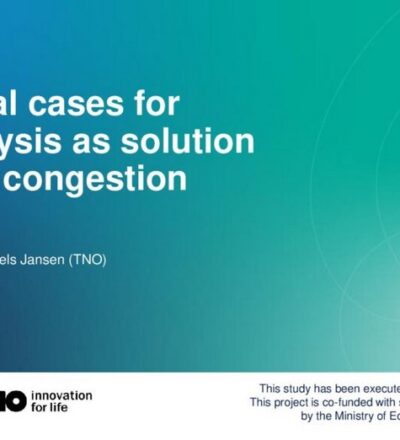Analysis of 4 use cases of deployment of electrolysis for congestion management analyzed for legal feasibility, market potential and effect on congestion.
With the growing supply of renewable energy, it is increasingly common for the electricity grid to be full: grid congestion. New energy sources cannot always be connected, causing delays in the energy transition. Storage of energy in hydrogen through electrolysis can provide a solution for congestion management in specific situations. Four different cases of this were evaluated in terms of legal issues, market potential and effects on congestion management.
Several solutions are conceivable for congestion management, including grid expansion, demand-side management and energy storage. Electrolysis is one of them and thus in competition with other solutions. To emerge as a solution, a good use case is necessary. This research shows that, for a use case to be feasible, it is important that both sufficient hydrogen off-take and renewable energy generation occur near the electrolyser. Legal feasibility is an important uncertain factor in the feasibility of the electrolyser and varies greatly from use case to use case.
Forms of deployment of electrolysis for congestion management
This study examined 4 forms of use of electrolysis for congestion management:
- Renewable generation: excess renewable energy generated is converted to hydrogen by the wind farm operator via electrolysis
- Industrial end-user: an industrial user has a constant demand for hydrogen. He can install an electrolyser to produce this hydrogen, which can only be used if there is enough space on the electricity grid.
- Energy Hub: In an energy hub, generation, use, conversion and/or storage of energy are combined behind the meter. Through conversion to hydrogen, the energy hub can store a surplus in generation itself.
- Grid Operator: the electrolyser is managed by the grid operator and deployed when there is a surplus of renewable energy.
Impact on congestion and feasibility business case
The impact on congestion and the feasibility of the business case do not necessarily go hand in hand. If a third party uses the electrolyser exclusively for congestion management, the main barrier is likely to be the business case. If only industrial demand is available near the electrolyser, this may have no or even a negative impact on local grid congestion. However, from an economic perspective, this may be a viable case.
The analysis shows that economic feasibility depends heavily on the presence of a local user (sufficient demand) of hydrogen, combined with sufficient willingness to pay. The cases with renewable energy combined with nearby industrial demand have the greatest potential for a feasible case.
The case with the greatest effect on congestion is the electrolyser managed by the grid operator. However, this is the most complicated in legal terms because as it stands, the grid operator is not allowed to own or manage energy assets.
Download your free copy
Our publications are free to access. Simply provide your first name and email address to download.
